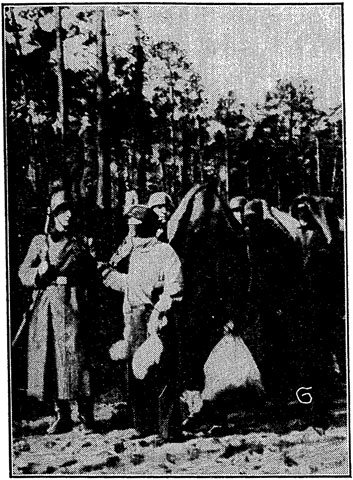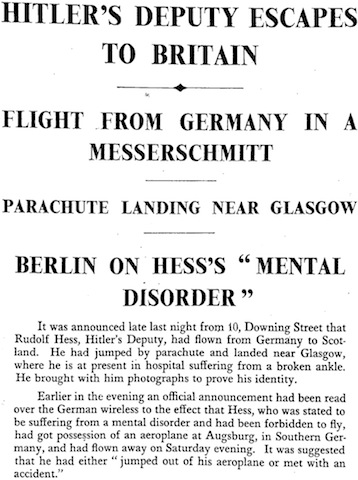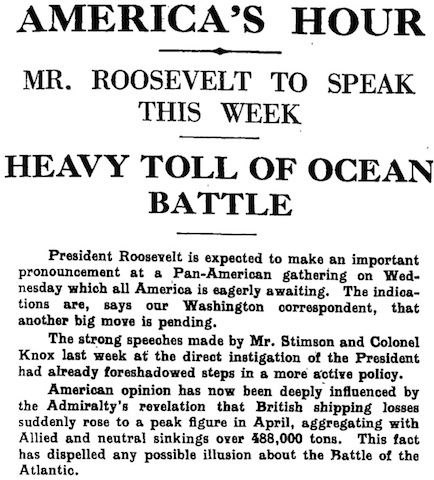
For the first time in a while, The Times and the Manchester Guardian differ in their lead stories. The latter (above, 5) focuses mainly on the surrender of seven thousand Italian soldiers in northern Abyssinia, but also notes a repulse of German armoured columns near Sollum and a new RAF attack on Vichy aerodromes in Syria. The Times deals only with Syria. There’s surprisingly little crowing in either paper about this victory; perhaps because Gondar and Gimma are still holding out, or perhaps because, as a leading article in the Guardian says, ‘As a nation […] we are more disturbed by our defeats than excited by our victories’ (4). But the The Times does rub salt into Italian wounds with a little article which points out that while it took the Italians ‘seven months to march 425 miles’ in their conquest of Abyssinia in 1935-6, ‘Imperial Forces have covered a distance of 1,500 miles in 94 days’ in order to free it (3).
Regarding Syria (where General Dentz ‘is now engaged actively in stabbing Great Britain in the back’, in the undiplomatic words of the Guardian‘s diplomatic correspondent), The Times relays an official communiqué which states that the RAF bombed Palmyra aerodrome: ‘one large German transport aircraft and one Heinkel 111 were destroyed by fire’ (4). Apparently this aerodrome is a major waypoint for the German air route into Iraq and is now staffed entirely by Germans. The suggestion has been made (it’s in the Guardian too, so it’s probably more or less official) that the aircraft being supplied to Rashid’s rebels are sans pilots:
This supposition is based on the fact that two Gladiators encountered two Me110s in the Baghdad area and shot them down without the slightest difficulty; this would hardly have been the case if the aircraft had been in the hands of skilled pilots.
Disturbingly, German dive-bombers have attacked three hospital ships in recent days: Aba, 120 miles south of Crete, and Vita and Karapura in Tobruk harbour. Aba was rescued by British warships ‘firing an “umbrella barrage“‘ (Guardian, 5). It was ‘full of wounded and plainly marked with red crosses’. Fortunately it seems that no casualties resulted from these attacks.
Another German dive-bomber was shot down, this one over ‘an East coast town yesterday morning’. A local who witnessed ‘this swift vengeance’ said:
The bomber came into sight from the clouds after we had heard the noise of engines. Suddenly he dived and released his bombs, but a [AA] shell hit him and his port engine caught fire. The flames quickly spread.
The previous night’s air raids were on ‘an extremely small scale’. A dawn raid on a ‘South-west Coast’ town hit a bungalow and killed three people. Two German aircraft were shot down overnight. In daylight, four Spitfires encountered ten Me 109s over the Channel and shot down half of them within five minutes, at no loss to themselves.
“It was grand,” said one of the pilots who accounted for two of the enemy, “but I could not stay long, for as soon as I had got my two I saw about 25 other yellow-noses coming at us. I had no more ammunition left, so I thought it time to go home.
Quite!
On Sunday night, Bomber Command ‘attacked Kiel and did further damage to its important shipbuilding yards’. According to the German New Agency, ‘No damage was done’, although some bombers ‘dropped bombs aimlessly on Northern German coast plains and destroyed a farm’.
In Edinburgh today, the General Assembly of the Church of Scotland will consider the question, among many others, of ‘Should there be any limit to reprisals which may be necessary to prevent defeat by an enemy guilty of unspeakable brutalities?’ (7)
From The Times (6):

UNDER THE GERMANS. — A photograph smuggled out of Poland showing blindfolded Poles being led away by S.S. troops into the woods at Palmiry, known as the Village of Death.
This is one of a number of photographs ‘taken for the Gestapo in Poland, for their records or for their amusement; they were stolen from a Gestapo office and smuggled out of Poland’ (4).
Most of the other photographs are unfit for publication in a newspaper. Men are seen hanged by the Germans in front of their own houses or hanged in public squares with children grouped around; there are scenes of execution in the woods at Palmiry, known to Germans and Poles alike as the Village of Death; women being taken off by the execution squad; men rounded up for forced labour.
According to the Germans’ own figures, ‘In the concentration camp at Oswiecim hundreds of Poles have died […] in recent months. The Germans admit the terror; indeed they boast of it’.
![]() This work is licensed under a Creative Commons Attribution-NonCommercial-NoDerivatives 4.0 International License.
Permissions beyond the scope of this license may be available at http://airminded.org/copyright/.
This work is licensed under a Creative Commons Attribution-NonCommercial-NoDerivatives 4.0 International License.
Permissions beyond the scope of this license may be available at http://airminded.org/copyright/.





